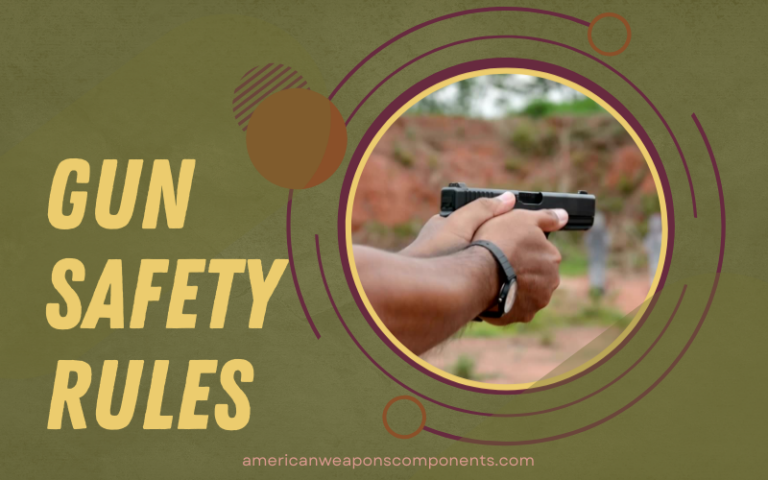Gun safety rules are not a joke.
In fact, every hunter and shooter who owns a gun should be well equipped with proper gun safety knowledge.
If you live in the United States, there are a ton of different gun safety courses available for you that we encourage you to attend, especially if you are a beginner.
It can be a bit frightening when you are first getting introduced to sport shooting or hunting, but it doesn’t have to be.
We have put together some great gun safety tips and resources to help you get comfortable with your rifle or pistol.
Whether you own a rifle or pistol, the first step would be to get comfortable with how the firearm functions and all its components.
Once you understand all the basics of your rifle or pistol, it is time to really learn gun safety rules.
The NRA is a great resource and provides a ton of information about proper handling and storage of your firearms.
During all my years of using guns, I have come to the realization that a lot of gun safety rules should be common sense to most people, but I have found that this is often not the case!
I will touch on some of the most important gun safety rules throughout this post and in no order.
By no means is this list meant to be all inclusive, and I encourage you to use this blog post as just once resource on your quest for becoming gun safe.
Gun Safety is Extremely Important
Everyone knows the controversy in the U.S. about gun safety and gun regulations and everyone has, and is entitled to, their own opinion.
I am not trying to argue either side of the gun regulation debate, all I am trying to do is encourage hunters and shooters to be aware of proper gun safety so no one gets hurt.
Whether you are out varmint hunting with your kids or target shooting at the range with your 30-06, gun safety matters.
I’m sure everyone has personal stories or has heard stories from their friends about what happens when gun safety isn’t followed. It can be terribly dangerous.
If you are a parent and just getting your kid into shooting, I am sure you want them to be equipped with the knowledge necessary to properly handle firearms. It’s just as important to teach gun safety for kids.
On the other hand, if you have just purchased a rifle for hunting or shooting at the range, sometimes it can be a bit frightening showing up with your buddies and not knowing the basic gun safety rules.
Tips for Proper Gun Safety
One of the biggest gun safety tips is to never assume that your firearm is unloaded. What I mean by this is that you should be handling your pistol or rifle like it is live, until you properly clear the rifle and insure that it is not loaded.
Whenever you pick up or are handed a rifle, pistol, or shotgun, you should go through the process of checking the chamber the magazine to insure that either of them aren’t loaded.
For instance, if you pull out your .22lr out of its case, the first thing that you should do is check to make sure the safety is ON and then remove the magazine and open the bolt. These are pretty simple steps and will make handing a firearm a lot safer.
If you are new to shooting and your buddy hands you a rifle and you aren’t sure about its mechanics and aren’t comfortable, then I would suggest that you ask them to show you the proper gun safety tips before receiving the firearm.
Another step beyond never assuming that your rifle is unloaded is to keep your firearm unloaded until you are ready to shoot.
We will get into proper storage tips later, but never have ammunition in your magazine or action until you are properly set up to shoot. Common sense, I know!
Whether you are at the range or not, another important gun safety rule is to avoid holding your finger on the trigger. Now I know most pistols or rifles are set up so that the most comfortable position is to have your finger on the trigger but avoid this temptation.
Again, whether you are getting your rifle from your gun safe or being handed a rifle from a friend, make sure to accept the firearm and keep your finger off the trigger.
This gun safety practice is also useful when hunting or at the range. Make sure to keep your finger off the trigger until you are comfortable and until your sights are on the target.
When handing a firearm, ALWAYS point the muzzle or barrel in a safe direction whether it is loaded or not.
If you are at the range, never point your rifle towards others and always point it in the safest direction. I can’t tell you what the safest direction will always be so common sense does prevail here.
Down and towards the ground is often considered a safe area to point your gun when handling. This gun safety measure is important in case your firearm was accidentally to go off.
When you are actually going to use your rifle or pistol, a very important gun safety rule is to ALWAYS know what is beyond your intended target. This seems like common sense but I will guarantee you that this safety tip is often not followed. If you are at a decent shooting range, than I would anticipate it to be properly set up and that you will be shooting into a hill or another designated area safely.
However if you are out hunting, make sure you know and can see beyond your target. Scope the area out, look at maps, talk to others, whatever you have to do to make sure you are comfortable with what is beyond that of which you can see.
If you are hunting with a long range rifle, the bullet can travel an extremely long distance depending on the trajectory. You can get in a whole lot of trouble if you are not careful.
Always make sure that you are using the proper ammunition for your firearm. I know it sounds simple, but sometimes it can get confusing if you are shooting a bunch of different calibre rifles and have a whole host of ammunition in front of you.
Think before you load. Check the cartridge each time before you load your magazine. For instance, the .22lr can feel a lot like the .17HMR if you are not careful.
Another gun safety tip that many hunters and shooters often forget is to always use proper ear and eye protection when shooting. If you are new to shooting, large calibre rifles can hurt your ears when they are fired in close proximity.
Wear ear plugs or ear muffs and use safety approved glasses. These safety precautions are very inexpensive and will save your ears and eyes down the road. If you are shooting with little ones, don’t let them be around firearms without proper protection.
Their ears are very sensitive at a young age and it will discourage them from shooting if their ears hurt. Whether or not you are shooting a small calibre rifle, or something larger such as a .308, proper ear and eye protection should be mandatory.
We don’t often think that cleaning your gun is also a great gun safety technique, but it is. Regular maintenance and cleaning of your gun will not only extend its useful life, but it will also act as a great safety measure.
There are great cleaning kits available for your gun so make sure to buy the specific cleaning necessities for your gun. Guns should be cleaned after every use for optimal performance and safety.
Gun Safety Rules for Storage and Transportation
Proper gun storage is essential for the well being of yourself and others in your household or when transporting your firearm. You can purchase either hard or soft rifle cases for relatively cheap and they offer great protection.
Trigger locks are probably the biggest way to insure proper gun safety and they cost next to nothing. I prefer to pay a bit extra and get trigger locks with codes as compared with those with a key. I always seem to lose the keys!
I always leave the trigger lock on until I am ready to shoot my rifle or pistol. Never store your ammunition in the same spot as you store your gun, unless they are both locked in a safe.
Gun safes, whether it is the traditional gun safe or a biometric safe, are the best way to store your rifle or pistol.
They come in all shapes and sizes and of varying qualities but a good gun safe is a great investment, especially if you own multiple firearms.
You can buy small, pistol sized biometric safes which are pretty cool or you can buy large gun safes that can hold multiple guns.
If you are serious about hunting and shooting and gun safety, that I would highly recommend purchasing a proper gun safe. It will give you piece of mind, especially if you have kids in your home.
Check with your local state regulation for specific rules around gun storage and transportation. If I am going out to the range or hunting, I always leave the trigger lock on my rifle until I am ready to use it.
I also keep it in a secure and locked case, and put the case in either the trunk of my car or under the back seat of my truck. Other guys put their secure rifles in their lock box however mine is usually packed with chainsaws, oil, and other things that I don’t want rubbing against my rifle.
Final Thoughts on Gun Safety Rules
Proper gun safety should be followed at all times. Gun safety rules are there to protect you and others around you when storing your firearm, transporting it, or using it. State laws may differ from time to time so make sure to find and research specific laws that may apply to you.
This guide was meant to give you a solid foundation on gun safety basics for your rifles, shotguns, or pistols.
Stay safe and happy shooting!

